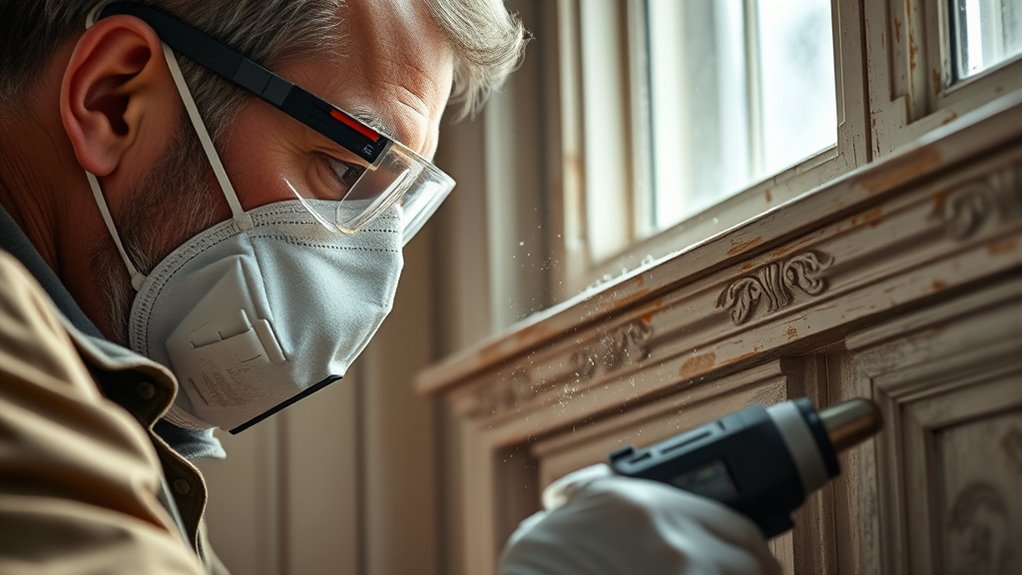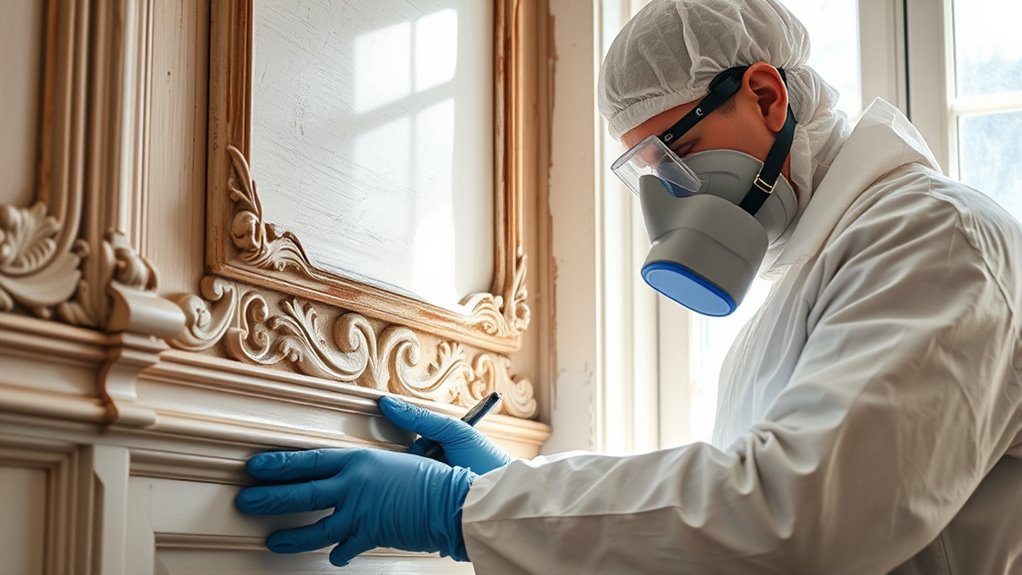To safely strip lead paint from antique trim, start by wearing a HEPA respirator, disposable coveralls, gloves, and eye protection. Seal off the workspace with plastic sheeting and turn off ventilation. Wet the paint with a damp cloth to minimize dust. Use a chemical paint stripper designed for lead removal and gently scrape with a plastic or metal knife. Afterward, clean thoroughly with a HEPA vacuum and damp cloth, disposing of contaminated materials safely. Following these steps will help you protect yourself and your home—learn more to ensure a safe and effective process.
Key Takeaways
- Use a certified lead-safe professional or follow strict safety protocols with HEPA respirators, disposable coveralls, gloves, and eye protection.
- Seal off the work area with plastic sheeting and turn off ventilation to contain dust and prevent contamination.
- Wet the antique trim surface thoroughly before applying a chemical lead paint stripper to minimize dust and lead dust release.
- Gently remove softened paint with plastic or metal putty knives, avoiding power tools or heat guns that can disturb lead paint.
- Clean the area with HEPA vacuum and damp cloths, then dispose of contaminated waste properly following hazardous waste guidelines.

Removing lead paint can be dangerous if not done properly, so safety should always come first. When you’re tackling antique trim with lead-based paint, understanding proper paint removal techniques is essential to prevent lead poisoning and protect your health. Lead poisoning prevention isn’t just about avoiding ingestion; it’s about controlling dust and debris that can become airborne during removal. Before you start, gather all necessary safety gear: a high-efficiency particulate air (HEPA) respirator, disposable coveralls, gloves, and eye protection. These tools help you minimize exposure to hazardous lead dust and chips.
Start by preparing your workspace. Seal off the area with plastic sheeting to contain any dust and prevent it from spreading to other parts of your home. Turn off ventilation systems and avoid any activity that could stir up dust. Wetting the paint surface with a damp cloth or water spray is a vital step—this helps reduce dust creation during removal. Remember, dry scraping can release dangerous lead dust into the air, so always keep the surface moist.
When selecting your paint removal techniques, opt for methods that generate the least dust. Chemical paint strippers designed for lead paint are often safer alternatives to dry scraping or sanding. Apply the chemical stripper carefully, following the manufacturer’s instructions, and work in small sections to maintain control. These products soften the paint, making it easier to peel away without creating excessive dust. Use a plastic or metal putty knife to gently lift the softened paint. Avoid using power sanders or heat guns, as they can disturb lead paint and produce harmful dust or fumes.
Once you’ve removed the paint, carefully clean the area. Use a HEPA vacuum to pick up dust and debris, then wipe down all surfaces with a damp cloth. Proper disposal is critical—place all contaminated materials in heavy-duty, sealed plastic bags and follow your local hazardous waste disposal guidelines. This step ensures that lead dust doesn’t contaminate your environment or pose a risk to others.
Throughout this process, stay vigilant about lead poisoning prevention. Regularly check for any signs of dust escaping your containment area, and don’t rush. If you feel unsure about any step, consider hiring a certified lead-safe professional. Research indicates sound vibrations can influence cellular regeneration and overall health, so maintaining a clean, controlled environment during removal is crucial. Following these paint removal techniques carefully not only makes the process safer but also ensures that you effectively remove lead-based paint without putting yourself or others at risk. Proper precautions and a methodical approach are your best defenses against the dangers of lead paint.
Frequently Asked Questions
Can I Strip Lead Paint Without Professional Help?
You can attempt DIY removal of lead paint if you first conduct lead testing to confirm its presence. Always wear proper protective gear and work in a well-ventilated area. Use safe, lead-specific stripping methods and avoid sanding or open-flame techniques. However, if you’re unsure or the area is extensive, it’s best to seek professional help to guarantee safe and effective removal, protecting yourself and your home.
What Are the Signs of Lead Paint Exposure?
You might notice symptoms like headaches, fatigue, or stomach aches, which often indicate lead poisoning from deteriorating paint. If you see peeling, chalky, or cracked paint, it’s a sign of paint deterioration that could expose you to lead. Lead poisoning can cause serious health issues, especially in children. Always get tested if you suspect exposure, and handle paint removal with care to prevent inhaling or ingesting lead dust.
How Long Does the Stripping Process Typically Take?
The stripping process for lead paint hazards usually takes a few hours to a day, depending on the size and condition of the trim. You’ll need to meticulously select stripping techniques that minimize dust and fumes, like chemical or heat methods. Your careful approach guarantees you effectively remove lead paint without exposing yourself to hazardous fumes, making the process safer and more efficient. Always follow safety guidelines during each step.
Are There Environmentally Friendly Lead Paint Removal Options?
You’re wondering if there are eco-friendly lead paint removal options. Yes, you can use natural paint strippers and eco-friendly solvents that minimize environmental impact. These products are designed to be safer for you and the planet, often made from plant-based ingredients. They effectively remove lead paint without harmful chemicals, making the process safer while still being effective. Always follow manufacturer instructions for the best results and safety.
What Safety Gear Is Essential During Lead Paint Removal?
When removing lead paint, you need to prioritize safety by wearing personal protective equipment like gloves, masks, and goggles to prevent exposure. Confirm proper ventilation strategies are in place, such as using exhaust fans and opening windows, to reduce dust and fumes. This combination helps protect you from inhaling or ingesting harmful lead particles during the process, making your work safer and more effective.
Conclusion
By following these safety steps, you can effectively strip lead paint from antique trim without risking health or damaging your home. Always wear proper gear, work in well-ventilated areas, and dispose of materials responsibly. Isn’t preserving the charm of your antique trim worth taking these precautions? With patience and care, you’ll restore its beauty safely—ensuring it stays a treasured part of your home for years to come.









